|
EM Senior Advisor William “Ike” White has been honored with the 2022 Presidential Rank Award for Distinguished Executive, joining a select cadre of senior executives lauded for sustained superior leadership performance. White was nominated for the award for his exemplary leadership in various U.S. government programs, most notably within DOE.
As EM’s most senior executive, White leads both field and headquarters operations for the largest environmental cleanup program in the world. Appointed to the Senior Executive Service in 2012, he has 30 years of demonstrated leadership, sustained superior performance and commitment to public service.
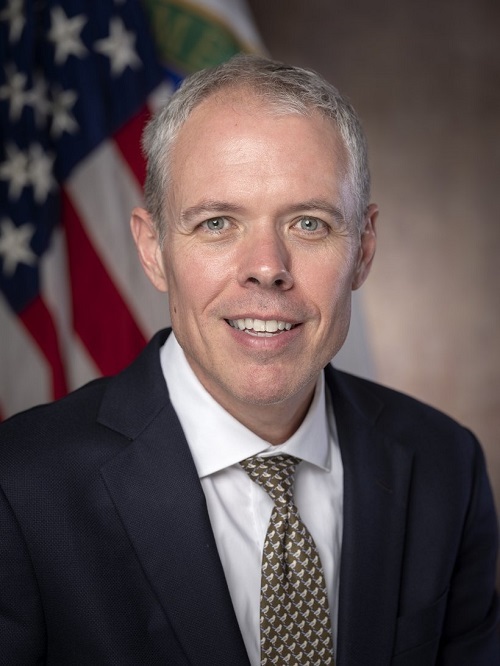 |
|
EM Senior Advisor William "Ike" White has received the 2022 Presidential Rank Award for Distinguished Executive.
|
Under White’s leadership, EM has made significant progress in liquid-waste treatment systems, including beginning operations at the Salt Waste Processing Facility at the Savannah River Site, completing construction of the facilities supporting the Direct-Feed Low-Activity Waste Program and beginning the first large-scale treatment of radioactive and chemical tank waste at the Tank-Side Cesium Removal System at the Hanford Site.
At Oak Ridge, demolition was completed at the East Tennessee Technology Park, making it the first site in the world to remove an entire uranium enrichment complex. At the Portsmouth Site, demolition of the X-326 uranium process building, a two-story structure covering 56 acres, was a critical achievement in the cleanup and transformation of the gaseous diffusion plant. The safe demolition of a 320-foot-high exhaust stack at the Brookhaven National Laboratory Site in Long Island, New York, completed the EM mission at the site, reducing the number of active EM cleanup sites from 16 to 15.
White issued EM’s 10-year Strategic Vision, the first after many years, providing an outline for planned accomplishments over the next decade, and the annual Priorities Scorecard summarizing achievements.
In addition to the many technical achievements and progress seen under his tenure, White led EM through the global pandemic, transitioning the program to remote work, ensuring the safety of every employee across the country and championing the EM mission despite uncertainty and turmoil.
|
Jay Mullis, EM's acting associate principal deputy assistant secretary for regulatory and policy affairs, received the Meritorious Executive Award as part of the 2022 Presidential Rank Awards.
|
|
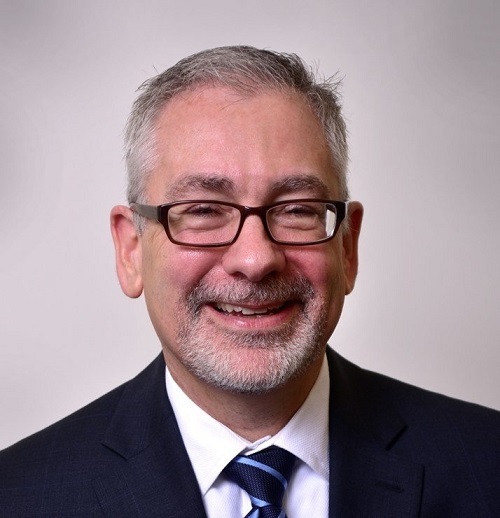 |
EM’s Jay Mullis won a Meritorious Executive Award as part of the 2022 Presidential Rank Awards. Currently serving as the acting associate principal deputy assistant secretary for regulatory and policy affairs at EM’s headquarters, Mullis previously served as manager of the Oak Ridge Office of Environmental Management from November 2017 until November 2021.
The Meritorious Executive award is the second-highest annual award for career members of the Senior Executive Service, recognizing individuals for sustained accomplishment. Recipients are leaders, professionals or scientists who achieve results and consistently demonstrate strength, integrity, industry and a relentless commitment to excellence in public service.
The Civil Service Reform Act of 1978 established the Presidential Rank Awards Program to recognize a select group of career members of the Senior Executive Service for exceptional performance over an extended period of time. Later, the Rank Award statute was amended to extend eligibility to senior career employees with a sustained record of exceptional professional, technical and scientific achievement recognized on a national or international level.
-Contributors: Sommer Porter, Tameka Reeves
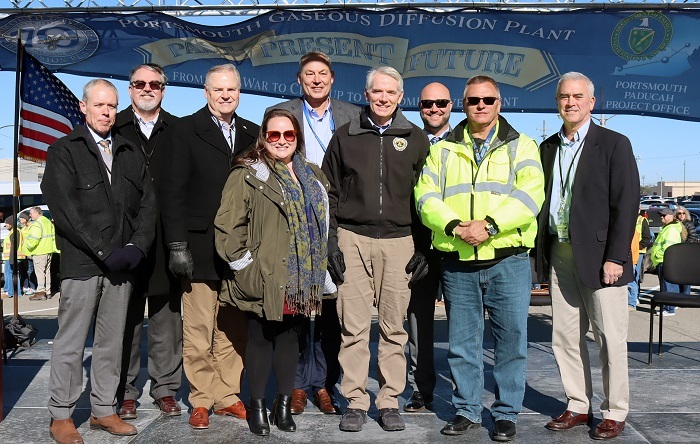 PIKE COUNTY, Ohio – EM’s Portsmouth Site marked its 70th anniversary on Monday with its “Past, Present, Future” celebration. The purpose of the event was to celebrate the workforce and its commitment to 70 years of service, the demolition of the X-326 process building and DOE’s upcoming transfer of about 200 acres of land for future use. Shown from left are William “Ike” White, EM senior advisor; Steve Shepherd, Southern Ohio Diversification Initiative; Mark Johnson, state representative; Ellen Smith, U.S. Sen. Sherrod Brown’s office; Joel Bradburne, Portsmouth/Paducah Project Office manager; U.S. Sen. Rob Portman; Jeremy Davis, Portsmouth Site lead; Herman Potter, USW president; and U.S. Rep. Brad Wenstrup. Check out the EM Update on Dec. 6 for a full story on the celebration.
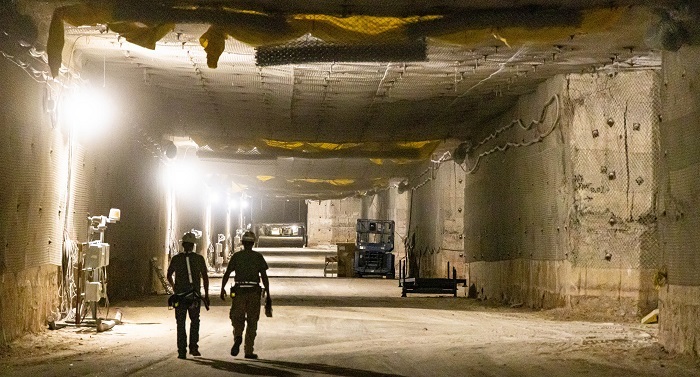 Two workers stroll down a passageway in Panel 8 at the Waste Isolation Pilot Plant after transuranic waste operations began there earlier this month.
CARLSBAD, N.M. – Employees have begun emplacing defense-related transuranic (TRU) waste in Panel 8 of EM’s Waste Isolation Pilot Plant (WIPP).
Panel 8 consists of seven emplacement rooms, each measuring 33 feet wide, 16 feet high and 300 feet long, the length of a football field minus the end zones. Creating a panel requires mining nearly 160,000 tons of salt. The panel is cut out of a 2,000-foot-thick layer of salt laid down 250 million years ago by the Permian Sea.
WIPP marked a milestone last month when employees finished emplacement in Panel 7 with the last of 20,056 containers. The most common containers, 55-gallon drums, totaled almost 13,000.
Emplacement began in Panel 8’s Room 7 with waste containers from Oak Ridge National Laboratory in Oak Ridge, Tennessee. Panels are filled back to front; it normally takes about 2.5 years to fill a panel.
“We have already seen significant increases in our efficiency as we have emplaced in Panel 8 compared to Panel 7,” said Sean Dunagan, president and project manager of Nuclear Waste Partnership, the WIPP management and operations contractor. “WIPP has the best workforce of anywhere in the complex, and I am so excited for the team as we make this significant move in Panel 8.”
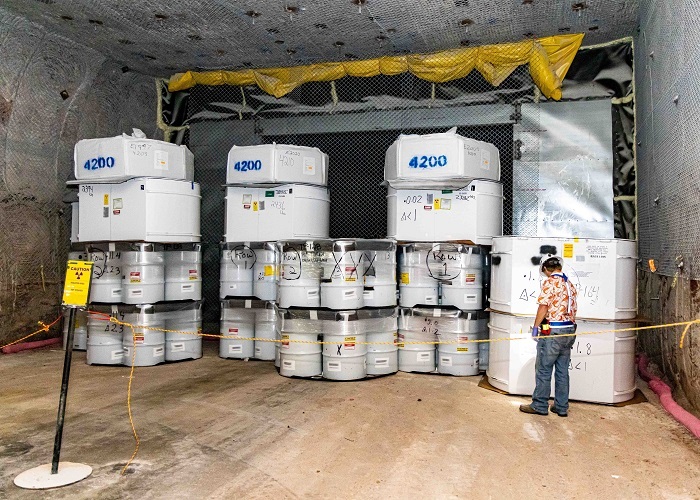 A radiological control technician checks radiation readings on waste containers in Room 6 of Panel 8 at the Waste Isolation Pilot Plant. Employees successfully emplaced the first defense-related transuranic waste in the panel earlier this month.
WIPP has been disposing TRU waste since 1999, cleaning up 22 waste generator sites across the DOE complex. TRU waste contains manmade elements heavier than uranium on the periodic table and consists of clothing, tools, rags, residues, debris, soil and other items contaminated with small amounts of plutonium and other man-made radioactive elements. The waste is permanently disposed in rooms mined in an underground salt bed layer 2,150 feet below the surface.
Construction of WIPP followed congressional passage of the WIPP Land Withdrawal Act in 1992, which approved emplacement of up to 6.2 million cubic feet of waste. Emplacement in WIPP’s Panel 1 began in 1999.
-Contributor: Roy Neese
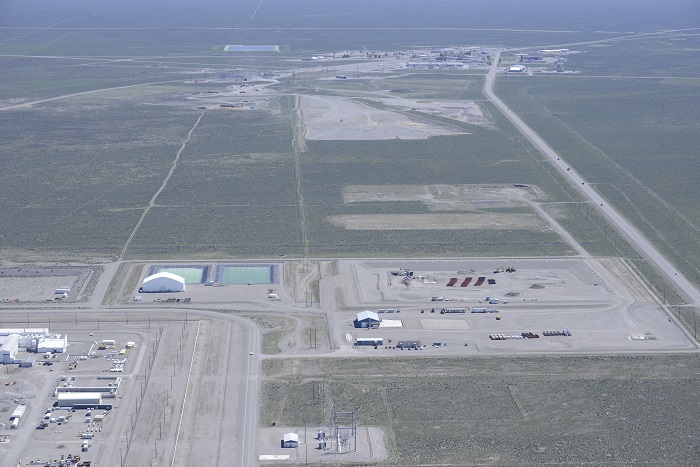 EM, the U.S. Environmental Protection Agency and state of Idaho have agreed to expand the Idaho CERCLA Disposal Facility at the Idaho National Laboratory Site by creating a new disposal cell adjacent to the existing cell at the center of the photo.
IDAHO FALLS, Idaho – The Idaho National Laboratory’s (INL) Site’s largest, active landfill will be expanded to accommodate the disposal of contaminated soil, debris and even reactor vessels for an additional 25 years following approval recently by EM, the U.S. Environmental Protection Agency (EPA) and the state of Idaho.
To continue advancing the EM cleanup mission at the INL Site, the three entities agreed to increase the capacity of the Idaho CERCLA Disposal Facility (ICDF) and construct an additional disposal cell and lined ponds for landfill moisture control nearby ICDF to allow for future waste disposal. CERCLA stands for the Comprehensive Environmental Response, Compensation and Liability Act.
Like the current landfill, the new disposal cell would have strict waste acceptance criteria. The cell will be comparable in design and construction to the existing landfill and will meet applicable state and federal regulations.
“Expanding this EM asset is crucial to maintaining our excellent cleanup program track record,” said Dan Coyne, senior director of Waste and Decontamination/Demolition for EM cleanup contractor Idaho Environmental Coalition.
The ICDF has a disposal capacity of 390,000 cubic meters — about 10 football fields in size — and has provided onsite waste disposal while providing long-term protection of human health and the environment since its opening in 2003. The facility consolidates waste and radioactively contaminated decontamination and demolition debris from many areas of the 890-square-mile INL site, reducing the footprint into a single, managed and controlled area.
Disposing waste at the ICDF reduces potential risk of groundwater contamination and has saved taxpayers hundreds of millions of dollars versus shipping the material out of state across public highways for offsite disposal.
Located in the southcentral portion of the INL Site, the landfill is about 80% full. Without increasing its capacity, it would be full in 2025.
EM, EPA and the state authorized a waste disposal increase for the existing cell by 140,000 cubic meters within the same footprint. Once filled, the cell will be covered with a cap designed to prevent water from infiltrating into the disposed waste. They also authorized construction of a new disposal cell with a waste disposal capacity of 530,000 cubic meters The new landfill cell is projected to start receiving waste in 2026 and will be designed to have an operational life of at least 25 years.
EM, EPA and the state, in collaboration with the Naval Nuclear Propulsion Program (NNPP), recently outlined plans to demolish the Submarine 1st Generation Westinghouse (S1W) and Aircraft Carrier 1st Generation Westinghouse (A1W) reactor buildings, the reactor vessels and associated debris. One option being considered is to dispose the debris and associated reactor vessels at the ICDF. Later, the agencies and NNPP plan to complete footprint reduction at the facility with the demolition of the Submarine 5th Generation General Electric (S5G) facility, the reactor vessel and associated debris.
-Contributor: Erik Simpson
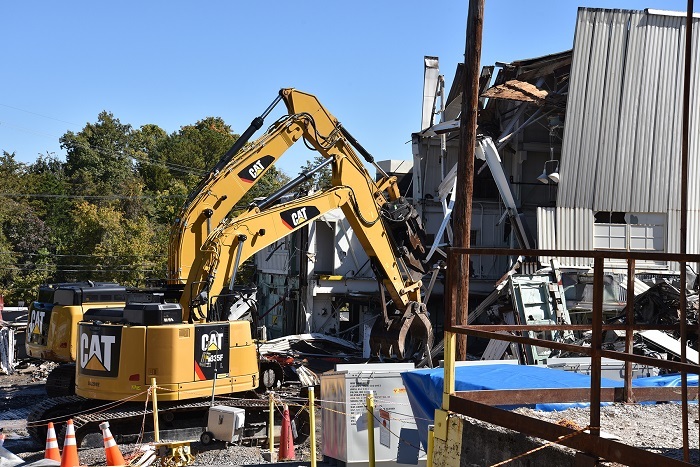 EM crews demolished the Bulk Shielding Reactor this fall in Oak Ridge National Laboratory’s central campus. The teardown provided a major landscape change at the site, and is the first of many projects that will eliminate risks and remove radiologically contaminated buildings there.
OAK RIDGE, Tenn. – DOE’s Oak Ridge Office of Environmental Management (OREM) recently unveiled its vision for the next decade to employees and partners, and progress is already under way toward achieving it.
OREM shared the vision in its new 10-Year Program Plan. This edition provides a course for cleanup operations across the Oak Ridge Reservation from 2022 through 2032, complete with specific goals, objectives, performance measures and timelines.
The newly released document comes nearly 10 years after the release of the site’s initial program plan. That document established major cleanup goals and set clear expectations for employees and contractors that led to strong results. Now, there is an updated list of goals for the years ahead with the same purpose in mind.
“Our initial plan proved extremely helpful. It gave us a unified version to strive toward, and it led us to achieving some of our most ambitious endeavors ahead of time and under budget,” said OREM Acting Manager Laura Wilkerson. “As I look at what we have accomplished in recent years, I am eager to witness the ongoing transformation and new opportunities created for the Department and local community by our mission.”
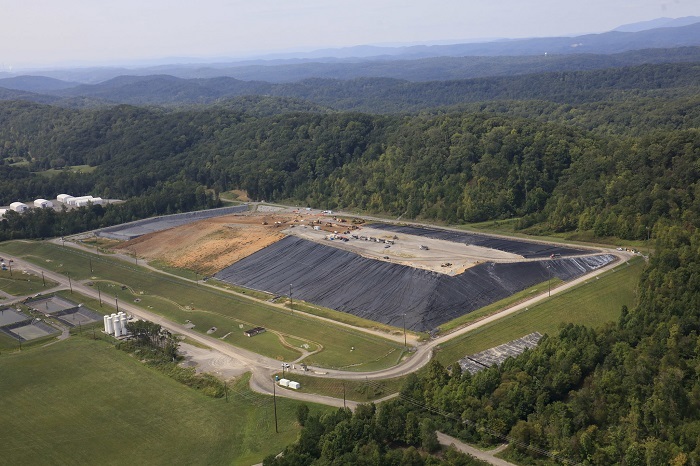 The Oak Ridge Office of Environmental Management’s (OREM) current onsite disposal facility, the Environmental Management Waste Management Facility, is at 83% capacity, and another facility is needed to continue cleanup at Oak Ridge National Laboratory and Y-12 National Security Complex. A recent record of decision allows OREM to begin site preparation and work to finalize the design for the Environmental Management Disposal Facility, which provides the capacity needed to finish remaining cleanup in Oak Ridge.
The 2022-2032 plan lays out four overarching cleanup goals for the workforce. These goals are a fixed target for employees to pursue, and they serve as a measurable method to gauge and track performance.
Over the next 10 years, OREM is set to complete soil and groundwater cleanup and complete all land transfers at the East Tennessee Technology Park (ETTP).
The workforce also will accomplish major transformation at Oak Ridge National Laboratory (ORNL) and the Y-12 National Security Complex (Y-12). Employees are scheduled to remove all uranium-233 inventory and debris transuranic waste at ORNL, clear away numerous former reactors and labs in ORNL’s central campus and begin the teardown of massive high-risk buildings at Y-12.
The new plan was released only weeks ago, but OREM has already achieved multiple performance measures contained in it.
Top highlights this fall include getting a final record of decision signed for the Environmental Management Disposal Facility, allowing OREM to move forward on a final design and begin site preparations for it; completing demolition on the Bulk Shielding Reactor at ORNL and former Criticality Experiment Lab at Y-12; and finishing facility upgrades necessary to begin processing operations on the remaining uranium-233 inventory stored at ORNL.
-Contributor: Ben Williams
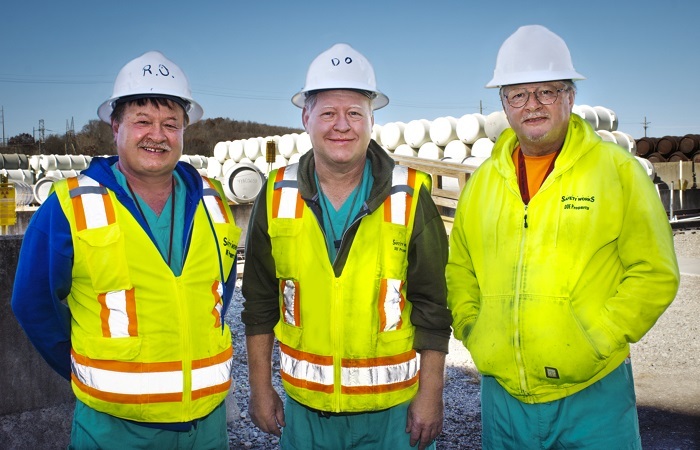 From left, uranium material handler operators Rick, Dave and Randy Osborne gather near one of the X-344 Feed and Withdrawal Facility cylinder yards at the Portsmouth Site.
PIKE COUNTY, Ohio – Most people may never get the opportunity to work with family members, but it’s been a harmonious family affair for a trio of brothers at the Portsmouth Site, who have worked together closely for the past 10 years.
Brothers Dave, Rick and Randy Osborne have worked side by side for the past decade as operators in Portsmouth’s X-344 Feed and Withdrawal Facility, where their responsibilities include quarterly tests of the facility’s autoclaves. Autoclaves are steam pressure vessels used to heat cylinders when transferring uranium material from thin- to thick-walled cylinders.
“It’s great working with your brothers if you get along. We learn a lot from each other, teach each other and watch out for one another. Communication is easier because the left and right hands know what is going on and everything flows together,” Dave said.
Rick and Dave previously worked in Cascade Operations together for 25 years. Cascade Operations refers to the network of buildings involved in the uranium enrichment process. Randy was hired in 2009 and worked two years in Cascade Operations with Rick and Dave before all three moved to the X-344 facility in 2012. The X-344 facility is where uranium hexafluoride (UF6) from obsolete thin-walled cylinders is transferred into thick-walled cylinders, sampled and stored for future use.
The trio grew up on a small farm in Beaver, Ohio, which is a village 12 miles east of the Portsmouth Site. They are collectively known as the “O-Team,” a nod to their last name.
“With three sets of eyes, there is less likely to be a mistake and Randy’s my ride to work, so we have to get along,” Rick mused. “We had to work together as kids to get the chores done on time so we could play sports together. It’s good to get along with both your family and your co-workers because it makes the 12-hour workday go by faster.”
As uranium material handlers, the brothers work with policies and procedures and address issues that arise.
“The job was challenging at first, but now we’re more confident, comfortable and in a routine,” Randy said. “When you’ve done a good job, you don’t have to take your worries home.”
Dave said the siblings look out for one another and speak up when something needs to be done.
“We watch after each other and get along well,” he said. “If we come across something that needs to be addressed, we stop, talk about it and listen to one another. We are truly blessed.”
Other family members have also been part of the three brothers’ working careers. Their oldest brother Mike worked in X-344 during the 1990s, and Rick’s son currently works in that facility.
-Contributor: Michelle Teeters
 Manhattan Project National Historical Park was selected as the 2023 “national stamp,” which is the large, eye-catching center stamp pictured here. Image courtesy of Eastern National.
DENVER – Manhattan Project National Historical Park (MPNHP) takes center stage as the national stamp in the 2023 Passport to Your National Parks Stamp Set.
The national stamp is the large center stamp in a collection of 10 stamps that honor national parks. Sure to become a collector’s item, the 2023 national stamp features three photos from the MPNHP locations at three EM sites — Los Alamos, New Mexico, Oak Ridge, Tennessee, and the Hanford Site in Washington state.
The park was selected for the stamp set because its locations and historical buildings represent the nation’s diverse geography while weaving together many themes of national importance.
“The park turns seven this month as it debuts in the 2023 stamp set. The national stamp provides a wonderful opportunity to showcase the park and invite people to learn about and visit the park throughout the year,” said Wendy Berhman, acting park superintendent.
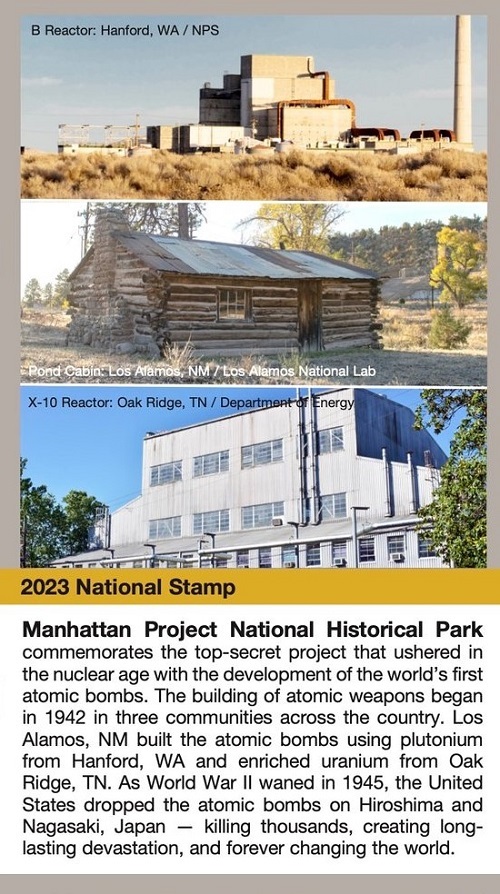 |
|
A closeup view of the large center stamp featuring the Manhattan Project National Historical Park in the 2023 Passport to Your National Parks Stamp Set, a collection of 10 stamps honoring national parks. Image courtesy of Eastern National.
|
MPNHP commemorates the top-secret project that ushered in the nuclear age with the development of the world’s first atomic bombs. The building of atomic weapons began in 1942 in three communities across the country: Los Alamos built the atomic bombs using plutonium from Hanford and enriched uranium from Oak Ridge.
The national stamp features three historic buildings: B Reactor in Hanford, Pond Cabin in Los Alamos and X-10 Graphite Reactor in Oak Ridge.
Since 1986, national park visitors have turned to the Passport to Your National Parks stamps to preserve memories of their park travel by collecting ink cancellations at each national park they visit. The Eastern National 2023 Passport to Your National Parks Stamp Set will be available through its retail outlets and through some of the park partners at each park site.
Managed in partnership by DOE and the U.S. National Park Service, MPNHP preserves and interprets the nationally significant historic sites, stories and legacies associated with the top-secret race to develop an atomic weapon during World War II and provides access to these sites consistent with the mission of DOE.
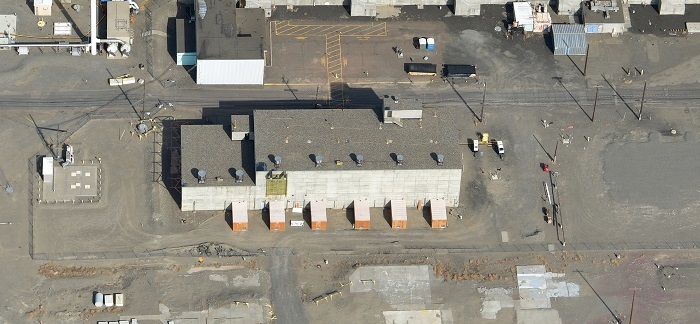 Constructed in 1944, the 224-B Plutonium Concentration Facility is one of the oldest buildings on the Hanford Site. The facility worked in conjunction with B Plant to support plutonium production activities until 1952. One of Hanford’s earliest plutonium processing facilities, B Plant operated from 1945 through 1957.
RICHLAND, Wash. – Crews with EM Richland Operations Office (RL) contractor Central Plateau Cleanup Company (CPCCo) are preparing the 224-B Plutonium Concentration Facility on the Hanford Site for demolition.
Last summer workers entered the facility process cells — where irradiated uranium fuel rods were processed to extract plutonium — for the first time since the mid-1980s, to remove debris. Teams are using noninvasive methods, like ultrasonic testing, to safely characterize any potentially hazardous material inside tanks and piping in the six cells.
“Making our first entries into the process cells and beginning preliminary characterization and cleanup activities is a big step in safely advancing this complex project,” said Andy Wiborg, RL Projects and Facilities Division team lead for Hanford’s Central Plateau Cleanup Project.
 Workers with EM contractor Central Plateau Cleanup Company entered former process cells — where irradiated uranium fuel rods were processed to extract plutonium — in the 224-B Plutonium Concentration Facility on the Hanford Site last summer. It was the first time in nearly four decades crews had entered the cells.
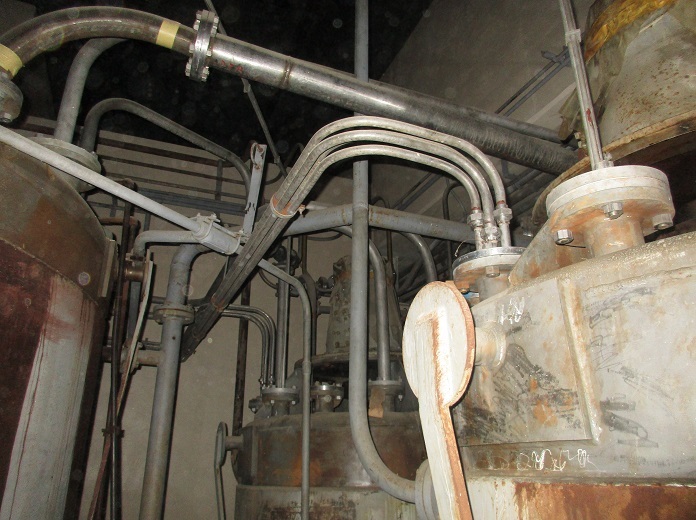 Workers must carefully plan and prepare to safely navigate a network of tanks and pipelines as they characterize potential hazards inside old process cells at the 224-B Plutonium Concentration Facility on the Hanford Site.
Constructed in 1944, 224-B is one of the oldest buildings located in the central part of the site. The facility worked in conjunction with B Plant to support plutonium production activities until 1952. The tanks and piping in the process cells were flushed in the mid-1970s, and the characterization will determine if there is any remaining solid or liquid waste that workers need to remove before demolition begins.
Navigating the congested process cells can be difficult for workers. Most of the cells contain multiple tanks — some as large as 9 feet tall and 9 feet in diameter — and a labyrinth of piping.
“This project presents a lot of unique challenges, but we’re making good, safe progress by relying on our training, communicating and looking out for each other,” said Jeremy Hulquist, CPCCo project manager. “Extensive research and detailed planning went into preparing for this cleanup project; it’s definitely a team effort.”
After completing characterization, the team will begin removing the equipment. The building is expected to be ready for demolition by the end of 2024.
-Contributor: Mark McKenna

Kristen Ellis, EM’s director of regulatory, intergovernmental and stakeholder engagement, recently participated in a virtual event to discuss how communities in and around the Hanford Site can build on its nuclear expertise to create science, technology, engineering and math (STEM) opportunities for the future workforce.
Among the many messages she delivered, one was as simple as it was important.
“We need to work with moms and dads to demystify science and engineering jobs,” Ellis said.
The 2022 Southeastern Washington Future Workforce Summit featured representatives from business, labor, education and government who are working on how to get students from the classroom to high-demand careers with a focus on creating new partnerships to close talent gaps and better prepare students for career success.
In a session titled “Building the Region's Clean Energy Workforce,” Ellis talked about how EM’s Hanford Site is reaching out to the next generation.
“Hanford created a professional development course designed to help teachers share Hanford information and career opportunities with students,” Ellis said. “They’ve also served as STEM ambassadors at various events, hosted students at the HAMMER Federal Training Center and are going into classrooms with students.”
Ellis also talked about reaching out to a variety of students with different backgrounds.
“The administration is looking to reach out to communities that have been left behind in the federal decision process,” she said. “We are working with tribes to get more of a cultural perspective within our processes. Northwest Indian College just received a grant that will help involve students who haven’t had such opportunities in the past.”
Hanford is located on the homelands of the Nez Perce, Umatilla, Wanapum, and Yakama tribes, all of which participate in DOE decision-making, so enhancing STEM opportunities available to tribal students benefits both the federal government and tribes.
This spring, Hanford employees joined nearly 400 students at the Nez Perce Tribe’s Environmental and Cultural Knowledge Day to give an overview of environmental cleanup and industrial and radiological safety. At a math and science camp this summer, employees met with students representing six different schools and four different tribes to talk about cleanup operations, technology and employment opportunities.
Ellis was joined at the Southeastern Washington Future Workforce Summit by John Eschenberg, president of EM Richland Operations Office contractor Central Plateau Cleanup Company, Washington state Sen.-elect Matt Boehnke and David Reeploeg, vice president of Tri-City Development Council. The group talked about leveraging both state and federal interest in STEM, reaching out to students at all levels, and retaining and recruiting talent and associated programs and approaches to realize real results.
“We are at a unique time for the nuclear industry and the potential of nuclear power in our climate goals is a key point to mention,” Ellis said. “We can do a better job of communicating about the work we do and how it’s different from the Cold War. That’s the key to being successful.”
-Contributor: Cameron Salony
|
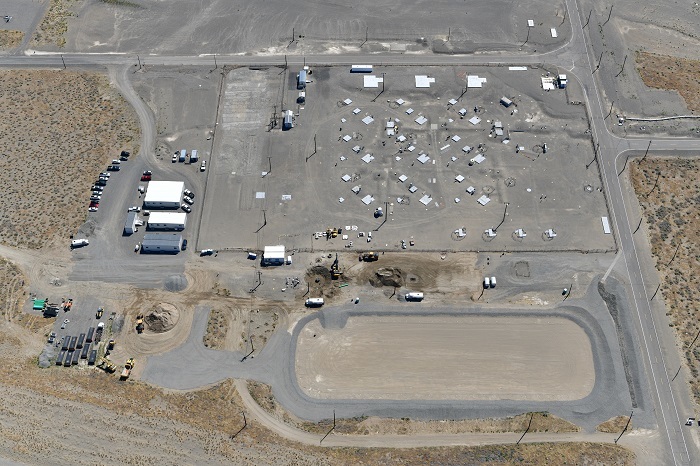 An aerial view of the U Farm, at top, in the 200 West Area of the Hanford Site shows the recently completed lined basin situated below the tank farm.
RICHLAND, Wash. – EM Office of River Protection (ORP) crews at the Hanford Site are preparing to install another asphalt surface barrier to divert water runoff to protect groundwater from contaminants.
The asphalt barrier at the U Tank Farm, one of the groupings of large underground waste-storage tanks on the Hanford Site, will divert rain and snowmelt into a nearby basin to hold the runoff while it evaporates. U Farm will be the fifth tank farm to have a surface barrier installed.
“These barriers are a critical part of the strategy to help protect groundwater at the Hanford Site,” said Becky Blackwell, ORP program manager. “The barriers help prevent rain and snowmelt from potentially mobilizing existing contaminants in the soil toward the water table deep below the surface.”
 |
|
A mixture of at least eight different types of native grasses and plants were spread over the top of the water runoff basin at the U Farm on the Hanford Site.
|
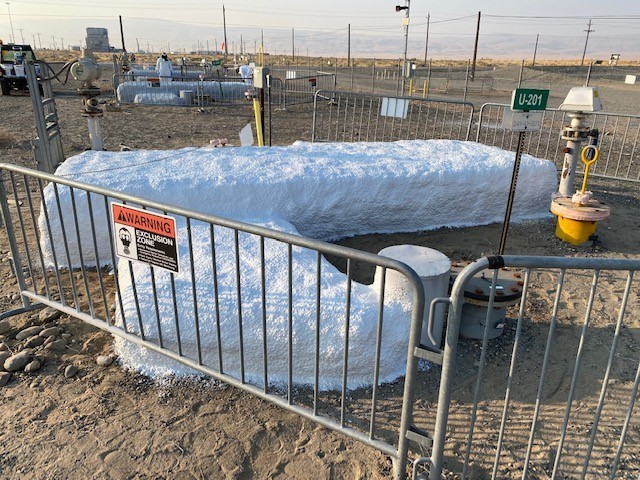 Equipment at U Farm on the Hanford Site is covered in foam insulation as crews prepare to install an asphalt surface barrier. Barrier construction is expected to begin next year.
WRPS will award a subcontract for construction of the barrier within the next few months.
Earlier this year, workers with tank operations contractor Washington River Protection Solutions (WRPS) and subcontractor Elite Construction and Development built and filled the lined basin with soil. Crews recently spread more than 60 pounds of native plant seed over the top of the basin, which is a little more than an acre in size. The plants and soil will encourage the natural evaporation of water.
“Waiting to put down seed until the weather starts to cool is a lesson learned from previous basin projects,” said Tom Sackett, WRPS Tank Farms Projects manager. “This seed will begin to germinate in the spring as the weather warms, which is more consistent with natural seeding.”
The U Farm consists of 16 underground, single-shell waste-storage tanks with a combined capacity of approximately 8.7 million gallons. The protective barrier at U Farm will be the latest interim barrier installed on the site.
-Contributor: Jenna Kochenauer
|